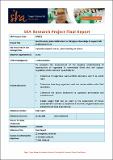| Abstract | The development and adoption of new varieties is a major investment in the Australian sugar industry. There are several modern techniques now being introduced into sugarcane breeding, such as introgression of Erianthus and the use of molecular markers. As these techniques contribute to better performing varieties these benefits can be readily captured through normal paths to market that have been established for improved varieties. Genetic modification (GM) is providing another method to introduce traits into crop plants. There is an increasing number of countries deploying a large number of GM varieties. This however, requires a different path to market involving regulatory systems that determine if there are potential harms that could result and what the likelihood of this may be. In Australia, environmental harm is assessed by the Office of the Gene Technology Regulator (OGTR). Some of the key considerations in determining the path to harms, in general, are an understanding of the reproductive biology (both sexual and asexual) of the crop. For sugarcane, a crop grown from pieces of stalk to harvest more stalks, the asexual propagation in farmer’s fields is relatively well understood. Sexual reproduction, however, has only been the concern of breeders and is not part of the productive cycle in farmer’s fields. In a previous project we have documented that flowering of sugarcane is widespread, though the Australian industry with a greater concentration from the Burdekin to Mossman. Within this area, viable pollen and seed production was found to be most significant from the Herbert to Mossman regions. Additional experiments demonstrated the potential for pollination and hence gene flow between fields and the presence of populations of a compatible wild relative, S. spontaneum. It was apparent that seed production occurred at a time not optional for seed germination. Consequently the current project has conducted studies to determine the likely fate in the environment of the sugarcane seeds and relate this to potential paths to harm, so that all future GM sugarcanes can be evaluated against this baseline. In this project we have used a combination of field and laboratory based studies. A third part of the methodology has been the use of a consultative group to assess both results obtained and plans for the coming year. These annual meetings involved representatives of the end users of the research. Both regulators and sugar industry representatives were active participants in this and have ensured the most relevant studies were conducted and end user engagement throughout the project. We have conducted extensive field work (i) to collect sugarcane seeds from farmer fields (ii) to assess the longevity of sugarcane seeds under field conditions and (iii) assess the likely competition between sugarcane seeds and weeds in the soil seed bank in and around sugarcane field. These studies were complemented by laboratory experiments that determined the abiotic limits to germination, the level of dormancy and the composition of sugarcane seeds. We demonstrated that in farmer’s fields in the most northerly areas, when sugarcane flowers, it has a low fertility and, the seeds that are produced are short-lived and rare in the soil seed bank in and around sugarcane fields. We established that sugarcane seeds do not display dormancy and germination could occur at relatively low temperatures (Tb=11°C - 16°C) with a base water potential of germination ranging from -1.1 MPa to -1.5 MPa. This means that, at least in Australia the major impediment to seed germination during the flowering period is the water availability. Significantly we showed that the number of weed seeds compared to sugarcane seeds in the seedbank was orders of magnitude higher, hence competition from weeds greatly limits sugarcane seedling establishment. Interestingly sugarcane seeds contain relatively high levels of lipid material compared to many other grasses. A link between composition and seed longevity was not established. In conclusion, we demonstrated that, in the Australian environment, the likelihood of sugarcane seeds establishing in the Australian environment is very low. Additionally as a result of the studies we have now developed several techniques that can be used to compare any changes in the response of the processes that comprise sugarcane sexual reproduction as a result of GM changes. When appropriate (for example when deliberate changes to abiotic stress tolerance have been engineered) these can be used to determine any biologically meaningful alterations. The results and implications of the project have been published in International Journals, discussed at ASSCT, discussed directly with regulators and have and will contribute to reference publications (biology documents) used by regulators world-wide. |

